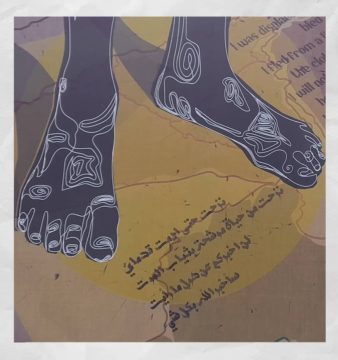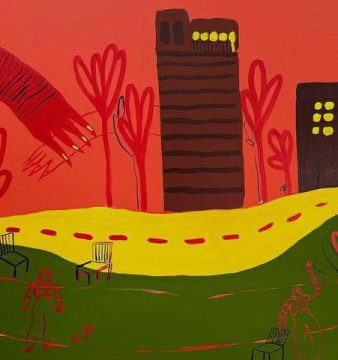In Conversation with Rising Artist Yasmin Elnour
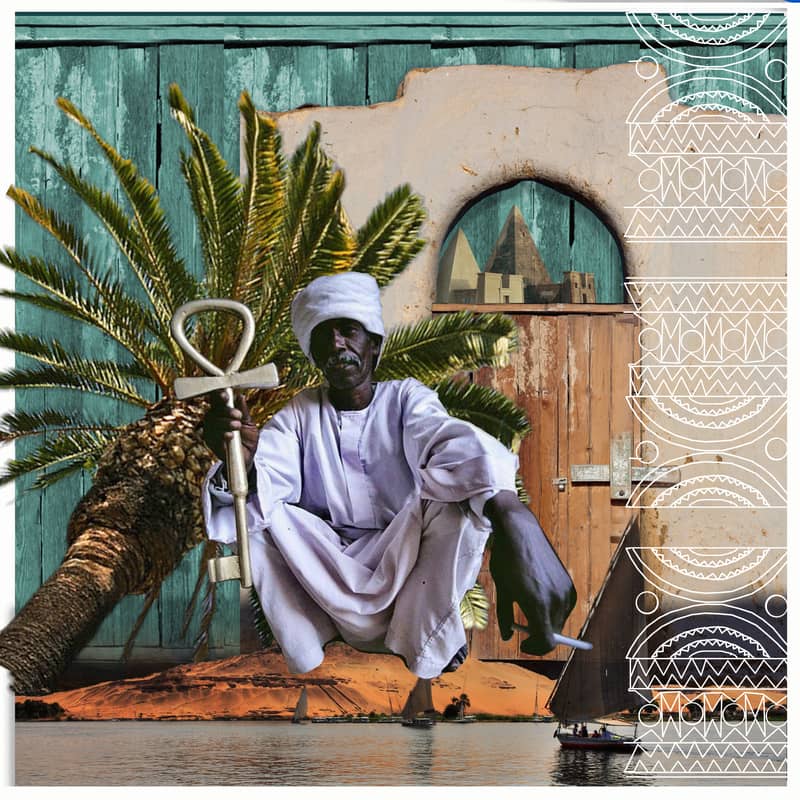
The Protectors of Nubia
Sudan is a nation blessed with diverse talents. From basket-weavers and sculptors, to jewellery makers and painters, art has always been an integral part of Sudanese culture.
With recent developments in technology and social media, digital visual artists have got the opportunity to make their own mark. Whether its graphic design, photography, or collages; Instagram and Twitter are two platforms flourishing with artists who are using social media platforms as forms of artistic self-expression, speaking to a wider audience from all over the world.
Sudanese architect, Yasmin Elnour, 26, is an artist whose thought-provoking work reflects upon a modern Sudanese identity. Her popular Instagram art account, @kandaka.khronicles, is an explosion of colour and personality which uniquely explores Nubian heritage and history. Elnour’s reach is growing with every piece she creates. Her images are beautifully manipulated in striking patterns and her powerful work is aimed at reminding the globalised Sudanese youth of the wealth they have been born into.
500 Words Magazine spoke to Yasmin Elnour to gain an insight into the inspiration behind her work process and where she sees it going.
How did you get introduced into collage art?
I graduated from architecture and started @kandaka.khronicles because I needed a creative outlet, but it all really started during my studies. I used collage as a way to express the concepts, narratives and the allegorical meanings of my buildings. As an art and communication form, collage helped me express what words often couldn’t. I realised it was a very effective way of expressing myself and my abstract ideas, so I stuck with it as my main mode of creative communication. My art allows me to express my creativity and love of colour while also giving me the freedom to view things in a different light. Along with helping me understand the multifaceted nature of design and inspiration, I also love that collage gives me a platform where I can advocate Sudanese and Nubian heritage.
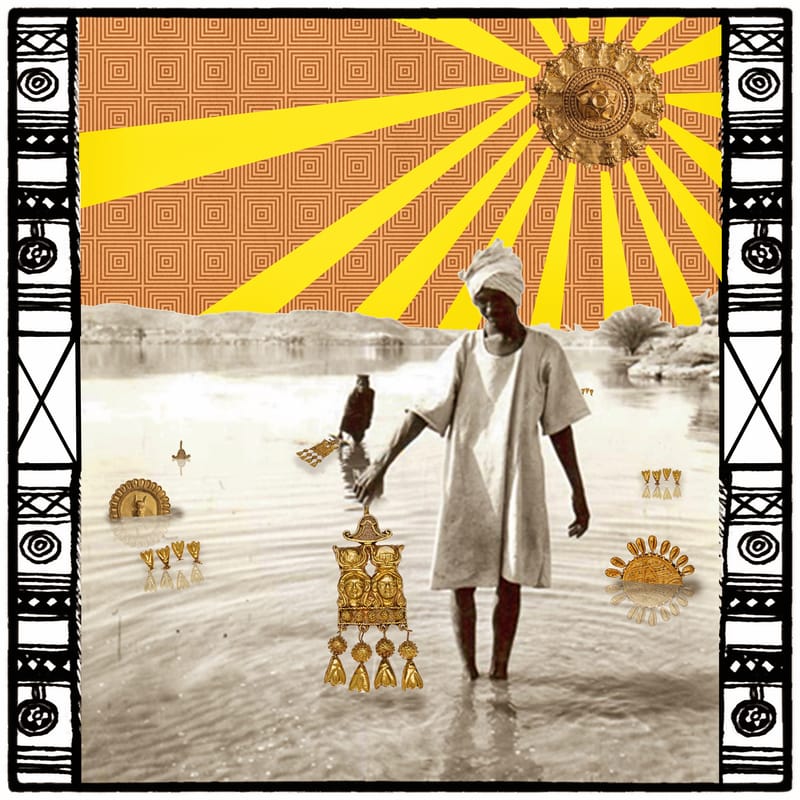
Fishing for Nubia
One of your pieces is a modern depiction of the pharaoh Taharqa. Do you draw these figures yourself or outsource from an archive?
At the moment, I use existing images sourced from online archives, books and even websites like Pinterest. I manipulate them using Photoshop and Illustrator to form or enhance my depictions of Sudan and Nubia. In a way, I’m paying homage and celebrating the times when Nubia and Sudan were in a better condition. Combining vintage images and patterns with modern colour-ways and filters oxymoronically is perfect with the message I’m trying to convey. In the near future, I will start including a variety of art mediums such as painting, sketching, and photography. Incorporating these would give my collages even more dimension, meaning and essence.
Your work is informative as well as aesthetically beautiful. What was your aim when you first started and what do you hope people will gain from it?
I am a blend of different cultures, and have always been interested in cultural heritage and identity, finding myself most in my Nubian origins. Following the flooding of the Nubian land in 1964 resulting from the Aswan High Dam, most of the intricate traditions, distinct architectural vernacular, and entire identities were lost. Many Nubians were forcibly relocated to a new settlement with no cultural identity, leading to the fragmentation of the Nubian culture as they knew it. Despite this, many feel a sense of nostalgia and longing for the old Nubia, sparking many efforts — particularly by Nubian youth — to revive the culture. In a sense, I am attempting to redefine what it means to be Nubian, rekindling former traditions and reviving images of a better Nubia and Sudan.
It has, and always will be my aim to be an advocate of not only Nubian culture, but Sudanese culture as a whole. My work is greatly influenced by identity and what this means in the 21st century. I feel we, the Sudanese youth, are increasingly asking ourselves: are we African, Arabs or just Sudanese? I try to weave that into my work. Personally, I would like to challenge this modern identity, and remind the globalised youth of today, including myself, about our heritage. I really want it to be as informative as it is aesthetically pleasing, and make it accessible for audiences to acquire a genuine appreciation for Sudanese and Nubian heritage while also feeling inclined to support the cause.
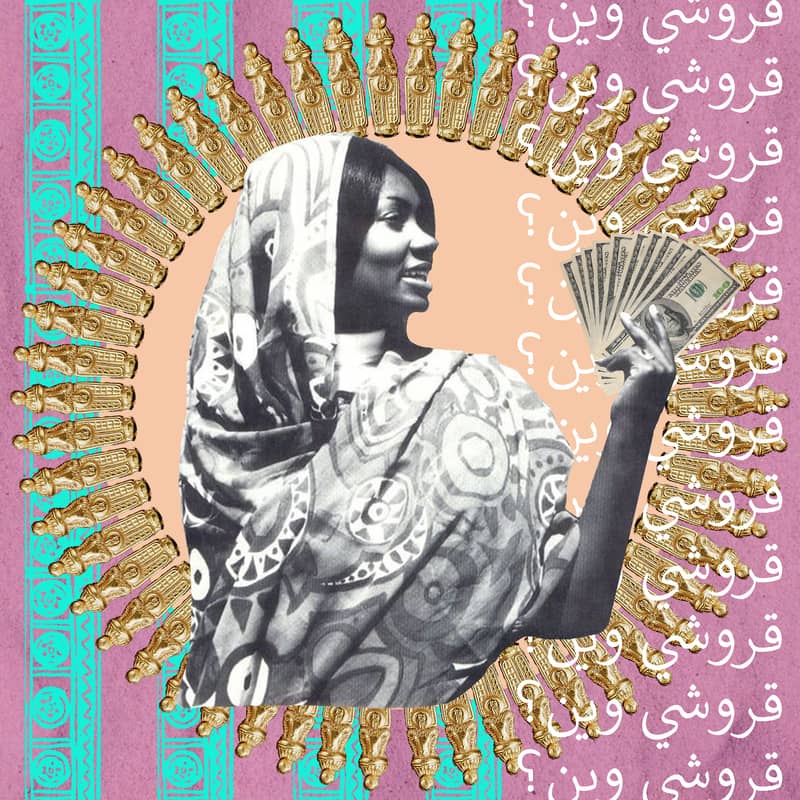
Gurushi Wein
Your work keeps getting better and better and I always stalk your account to obsess over your new artworks. I’m happy to see the growth in your work and the response to it. What are your plans for the future?
Thank you very much. I’m so glad to see that many enjoy my work. So far, I have mainly focused on collaging Nubian images, artefacts and patterns. One of my latest pieces however, pays homage to Sudanese women and their fight for equality. In the future, I wish to use my collages to tell more stories about culture, pop-culture, feminism, current and historical events, amongst other relevant topics. I hope to go on to make even more powerful and detailed images that speak louder volumes. For the moment, however, I would like to continue collaging, but I’m open to other projects and possible collaborations in the future.
Your style is very distinct from other Sudanese artists. What has been your visual influence and your process towards developing this intricate and colourful style?
I am heavily inspired by Nubia, I feel like there’s a story to tell. The Nubian culture and architecture is so colourful and full of patterns and inspirational shapes and forms that I can only try to capture a part of it in my work. In a nutshell, my process is simply a spontaneous, experimental journey with no specific final destination which often leads me to unexpected places. It’s a collage journey combining typography, photography and colour. I enjoy mixing modern and traditional elements together, which somehow harmonise to convey my message. I also have a passion for shape and space, which is how I’m able to piece the images together. Generally, I tend to incorporate textures that remind me of Nubia into the collages. These can range from images of sand and bodies of water, to jewellery and bricks. Not only am I paying homage to Nubia in the overall message and image, but I’m also incorporating Nubian components into the composition.
Each of your art pieces really tells its own story, but despite this, your feed is very cohesive and the individual pieces still work together beautifully. What’s the typical process for one piece, which has so far been consisted of three photo series? How much planning goes into each piece? How far ahead do you have to plan?
Some pieces take me half an hour, some take some days and some weeks. I just start whenever I find a spark of inspiration and depend on the piece to lead the way. I sometimes start with an image I like, and then build on it using other images, which are not necessarily related, in order to tell a story. Other times I start with a concept/story and build on that. I let the collage decide for itself when it’s finished and I just leave it there. The beauty of a collage is in its absurdity, the mixing and matching allows you to come up with new combinations that you never thought were possible. The important thing is that it comes out organically. I take my time crafting every piece and make sure I don’t force it. Even then, I try to produce a couple of pieces a week. It is important to note, however that I never know how the final piece will look, which is what makes it exciting. Over all, it’s a very therapeutic, yet focussed process.
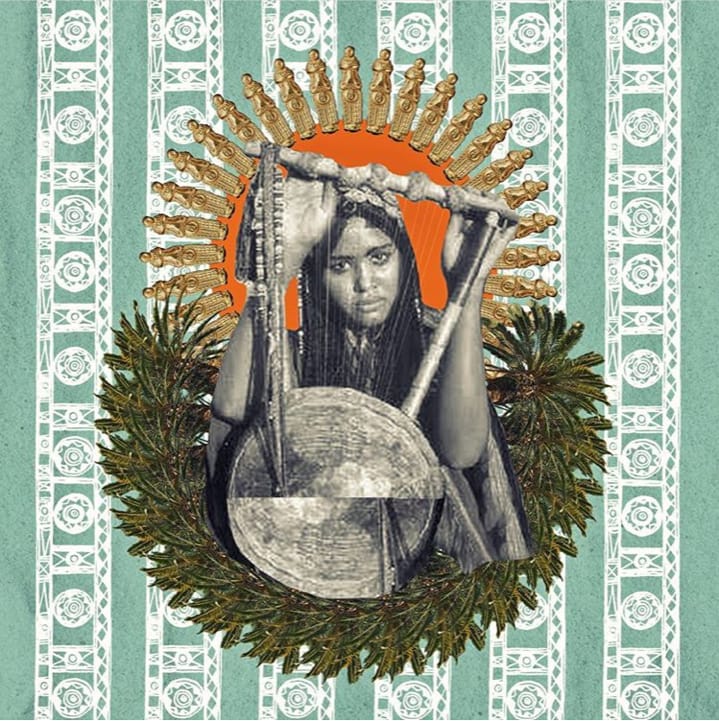
Palm Paradise
I love your ability to generate new content at an amazing pace without losing quality. How do you stay creatively inspired and maintain content?
I am always looking for inspiration and keep an eye out for images I can use. As an artist I feel it is important to be open and allow myself to be inspired by everything. Sometimes, I am inspired by nature and things I see in my everyday life. I also find concepts and real-life issues inspiring – one of my recent collages was inspired by feminism and the endless fight for gender equality. I also follow a lot of collage artists on social media which keeps me inspired as I’m always looking for examples from others.
You have mentioned that you have a background in architecture. What do you see yourself doing artistically in the future? Will you expand into other art forms?
I do have a Bachelor’s and Master’s degree in Architecture, but most importantly I am a student of design. The design process is similar across the arts and the creative process is the same, so it is natural for me to be into this type of storytelling. In the future, I want to expand into painting, drawing, and using my own photography in my works, perhaps even reflecting this artistic language I develop into my future building designs. I hope to explore other art forms including pottery, painting and photography which have always been passions of mine.
At the moment, I am trying to draw my own Nubian-inspired patterns and arrange them myself. I hope to expand into fully learning how these Nubian patterns, shapes and forms originally developed, so I can fully immerse myself and create my own depictions of these wonderful elements of Nubian identity.
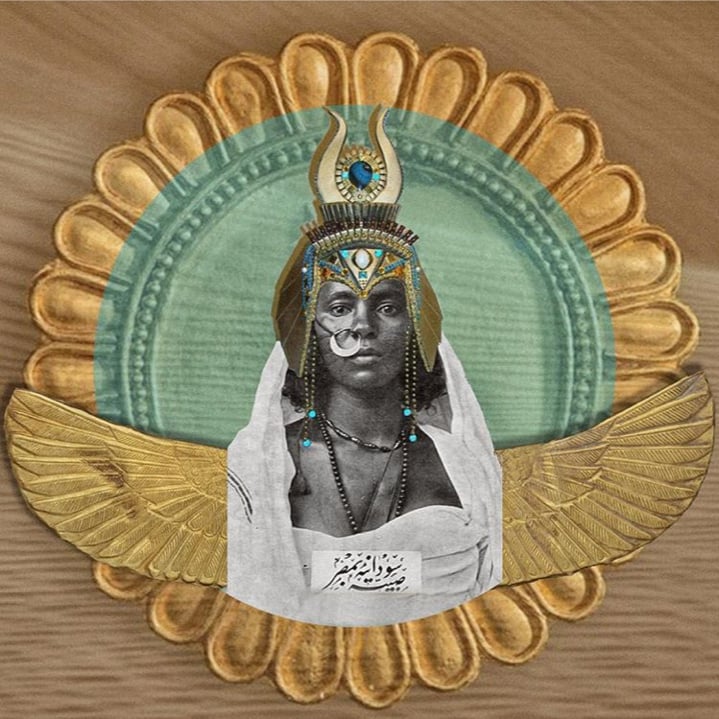
Kushite ISIS II
Have you considered branching out of the Instagram platform and creating large prints of your work? Is there an exhibition planned in the near future? And do you see yourself printing these pieces onto canvas, clothing or even the walls of Khartoum?
Yes! These are all things I plan to do. I will probably start printing them onto clothing and canvas first; and then move on to other mediums and outputs maybe even on products. I am working on potential collaborations as well. Perhaps I’ll arrange an exhibition soon. But in the meantime, Instagram will be my main mode of communication with my followers, but I am also considering other social media platforms.
A lot of artists find that starting a project like this can be trial and error as well as a massive learning experience. What’s the biggest thing you’ve learned so far since starting your Instagram account?
There are always people out there that will appreciate your work in some way. I have had an overwhelming amount of support and encouragement from my friends, family and followers and it means a lot to me because I had never shared my collages before. The main thing I have learned is that by being brave and entering uncharted territory, you’ll gain confidence in your abilities and find yourself further delving into your craft. It’s important to believe in yourself and the value of your expression.
What would you to say to someone who wants to follow your footsteps and explore this field but doesn’t know where to start?
Be open to being inspired by anything and everything. There are no specific techniques in collage, which is the beauty of it. Anyone and everyone can express themselves just like in any other art form. So my advice is collect inspiring images, items or even topics and just start putting things together, start layering and even if it looks absurd at first, keep going. The more eager you are to experiment, the better the result will be. Just keep at it, you’ll get better over time!
Follow Yasmin Elnour on her Instagram handle @kandaka.khronicles to learn more about her art.
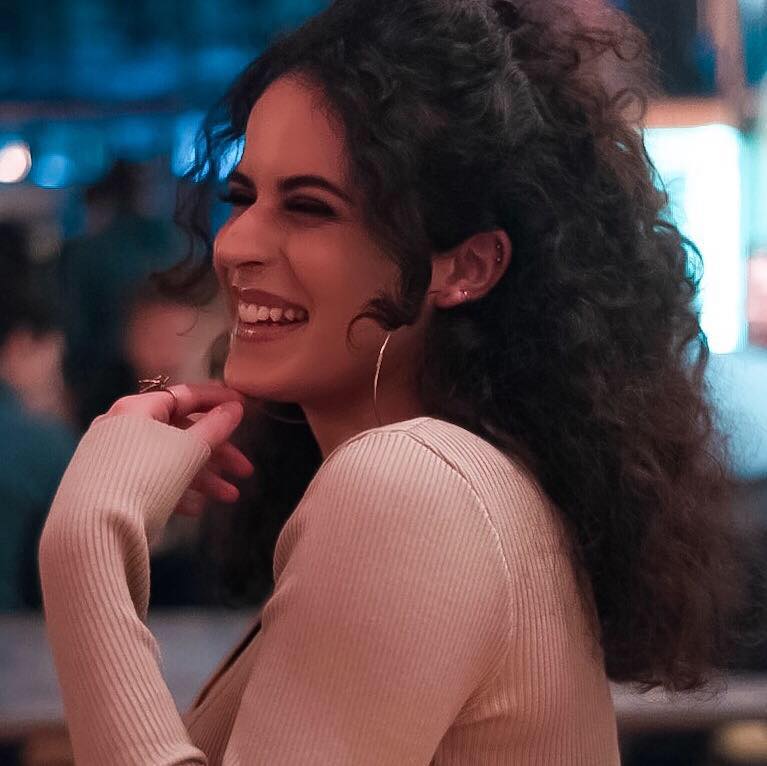 Nadine El Roubi is a recent graduate from the University of Birmingham with a Master’s Degree in Creative Writing. She loves Sudan and anything artistic, and the combination of the two make her especially happy. Find Nadine El Roubi on Instagram at @nadineelroubi.
Nadine El Roubi is a recent graduate from the University of Birmingham with a Master’s Degree in Creative Writing. She loves Sudan and anything artistic, and the combination of the two make her especially happy. Find Nadine El Roubi on Instagram at @nadineelroubi.


